Types of Software Testing
In this section, we are going to understand the various types of software testing, which can be used at the time of the Software Development Life Cycle.
As we know, software testing is a process of analyzing an application’s functionality as per the customer prerequisite.
If we want to ensure that our software is bug-free or stable, we must perform the various types of software testing because testing is the only method that makes our application bug-free.
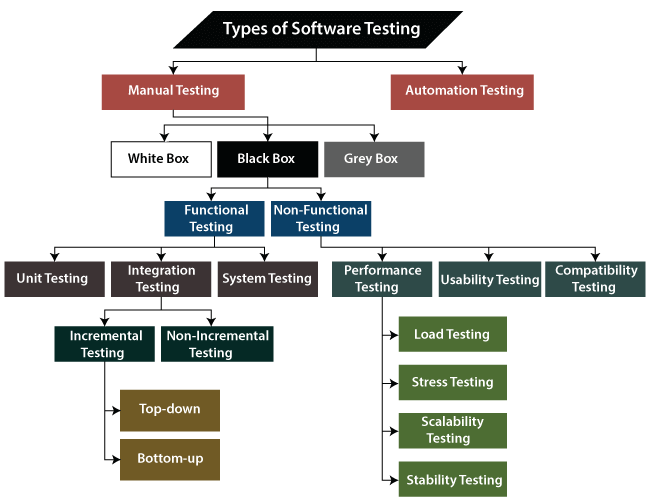
The different types of Software Testing
The categorization of software testing is a part of diverse testing activities, such as test strategy, test deliverables, a defined test objective, etc. And software testing is the execution of the software to find defects.
The purpose of having a testing type is to confirm the AUT (Application Under Test).
To start testing, we should have a requirement, application-ready, necessary resources available. To maintain accountability, we should assign a respective module to different test engineers.
The software testing mainly divided into two parts, which are as follows:
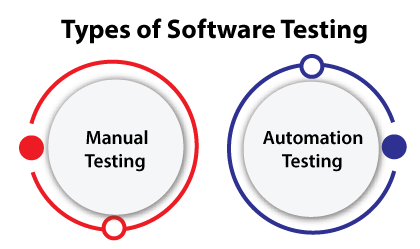
- Manual Testing
- Automation Testing
What is Manual Testing?
Testing any software or an application according to the client’s needs without using any automation tool is known as manual testing.
In other words, we can say that it is a procedure of verification and validation. Manual testing is used to verify the behavior of an application or software in contradiction of requirements specification.
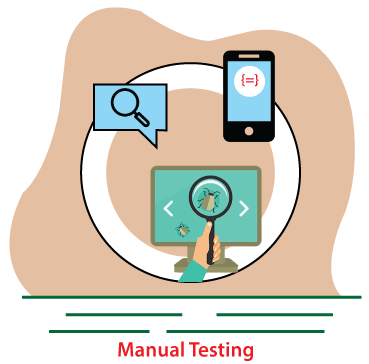
We do not require any precise knowledge of any testing tool to execute the manual test cases. We can easily prepare the test document while performing manual testing on any application.
To get in-detail information about manual testing, click on the following link: https://tutoraspire.com/manual-testing.
Classification of Manual Testing
In software testing, manual testing can be further classified into three different types of testing, which are as follows:
- White Box Testing
- Black Box Testing
- Grey Box Testing
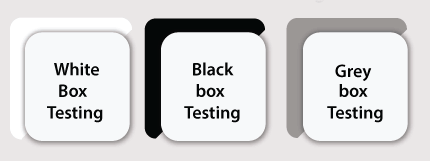
For our better understanding let’s see them one by one:
White Box Testing
In white-box testing, the developer will inspect every line of code before handing it over to the testing team or the concerned test engineers.
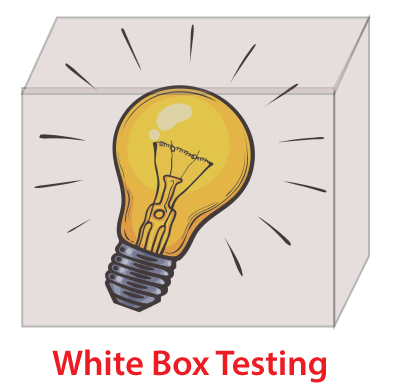
Subsequently, the code is noticeable for developers throughout testing; that’s why this process is known as WBT (White Box Testing).
In other words, we can say that the developer will execute the complete white-box testing for the particular software and send the specific application to the testing team.
The purpose of implementing the white box testing is to emphasize the flow of inputs and outputs over the software and enhance the security of an application.
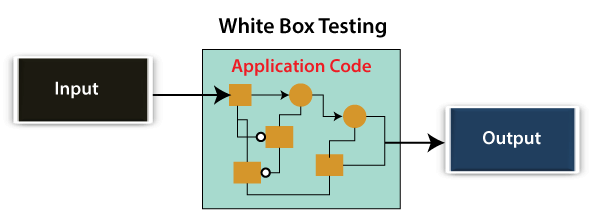
White box testing is also known as open box testing, glass box testing, structural testing, clear box testing, and transparent box testing.
To get the in-depth knowledge about white box testing refers to the below link: https://tutoraspire.com/white-box-testing.
Black Box Testing
Another type of manual testing is black-box testing. In this testing, the test engineer will analyze the software against requirements, identify the defects or bug, and sends it back to the development team.
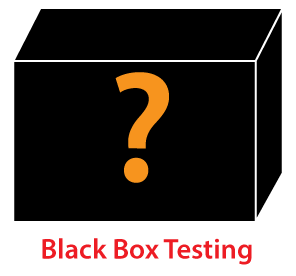
Then, the developers will fix those defects, do one round of White box testing, and send it to the testing team.
Here, fixing the bugs means the defect is resolved, and the particular feature is working according to the given requirement.
The main objective of implementing the black box testing is to specify the business needs or the customer’s requirements.
In other words, we can say that black box testing is a process of checking the functionality of an application as per the customer requirement. The source code is not visible in this testing; that’s why it is known as black-box testing.

For more information about Black box testing, refers to the below link: https://tutoraspire.com/black-box-testing.
Types of Black Box Testing
Black box testing further categorizes into two parts, which are as discussed below:
- Functional Testing
- Non-function Testing
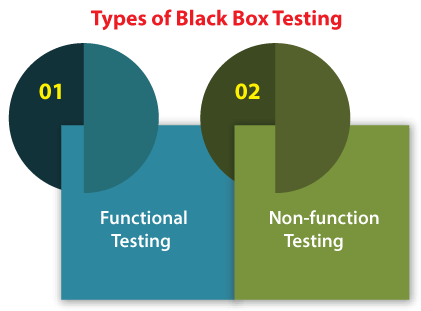
Functional Testing
The test engineer will check all the components systematically against requirement specifications is known as functional testing. Functional testing is also known as Component testing.
In functional testing, all the components are tested by giving the value, defining the output, and validating the actual output with the expected value.
Functional testing is a part of black-box testing as its emphases on application requirement rather than actual code. The test engineer has to test only the program instead of the system.
To get the detailed information about functional testing refers to the below link: https://tutoraspire.com/functional-testing.
Types of Functional Testing
Just like another type of testing is divided into several parts, functional testing is also classified into various categories.
The diverse types of Functional Testing contain the following:
- Unit Testing
- Integration Testing
- System Testing
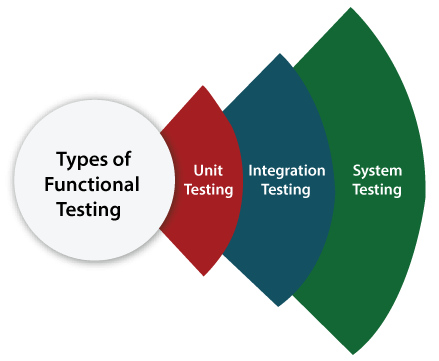
Now, Let’s understand them one by one:
1. Unit Testing
Unit testing is the first level of functional testing in order to test any software. In this, the test engineer will test the module of an application independently or test all the module functionality is called unit testing.
The primary objective of executing the unit testing is to confirm the unit components with their performance. Here, a unit is defined as a single testable function of a software or an application. And it is verified throughout the specified application development phase.
Click on the below link to get the complete information about unit testing: https://tutoraspire.com/unit-testing.
2. Integration Testing
Once we are successfully implementing the unit testing, we will go integration testing. It is the second level of functional testing, where we test the data flow between dependent modules or interface between two features is called integration testing.
The purpose of executing the integration testing is to test the statement’s accuracy between each module.
Types of Integration Testing
Integration testing is also further divided into the following parts:
- Incremental Testing
- Non-Incremental Testing
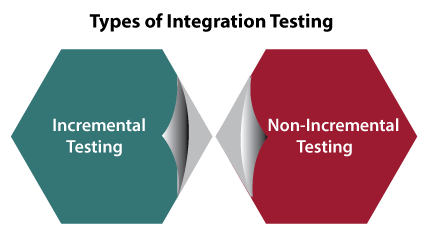
Incremental Integration Testing
Whenever there is a clear relationship between modules, we go for incremental integration testing. Suppose, we take two modules and analysis the data flow between them if they are working fine or not.
If these modules are working fine, then we can add one more module and test again. And we can continue with the same process to get better results.
In other words, we can say that incrementally adding up the modules and test the data flow between the modules is known as Incremental integration testing.
Types of Incremental Integration Testing
Incremental integration testing can further classify into two parts, which are as follows:
- Top-down Incremental Integration Testing
- Bottom-up Incremental Integration Testing
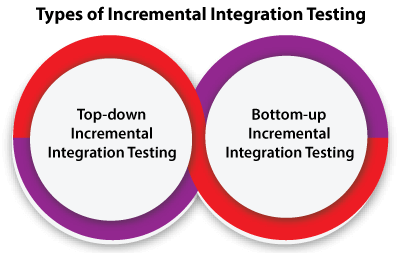
Let’s see a brief introduction of these types of integration testing:
1. Top-down Incremental Integration Testing
In this approach, we will add the modules step by step or incrementally and test the data flow between them. We have to ensure that the modules we are adding are the child of the earlier ones.
2. Bottom-up Incremental Integration Testing
In the bottom-up approach, we will add the modules incrementally and check the data flow between modules. And also, ensure that the module we are adding is the parent of the earlier ones.
Non-Incremental Integration Testing/ Big Bang Method
Whenever the data flow is complex and very difficult to classify a parent and a child, we will go for the non-incremental integration approach. The non-incremental method is also known as the Big Bang method.
To get the complete information about integration testing and its type refers to the following link: https://tutoraspire.com/integration-testing.
3. System Testing
Whenever we are done with the unit and integration testing, we can proceed with the system testing.
In system testing, the test environment is parallel to the production environment. It is also known as end-to-end testing.
In this type of testing, we will undergo each attribute of the software and test if the end feature works according to the business requirement. And analysis the software product as a complete system.
Click on the below link to get the complete information about system testing: https://tutoraspire.com/system-testing.
Non-function Testing
The next part of black-box testing is non-functional testing. It provides detailed information on software product performance and used technologies.
Non-functional testing will help us minimize the risk of production and related costs of the software.
Non-functional testing is a combination of performance, load, stress, usability and, compatibility testing.
For more information about Non-functional testing, refer to the following link: https://tutoraspire.com/non-functional-testing.
Types of Non-functional Testing
Non-functional testing categorized into different parts of testing, which we are going to discuss further:
- Performance Testing
- Usability Testing
- Compatibility Testing
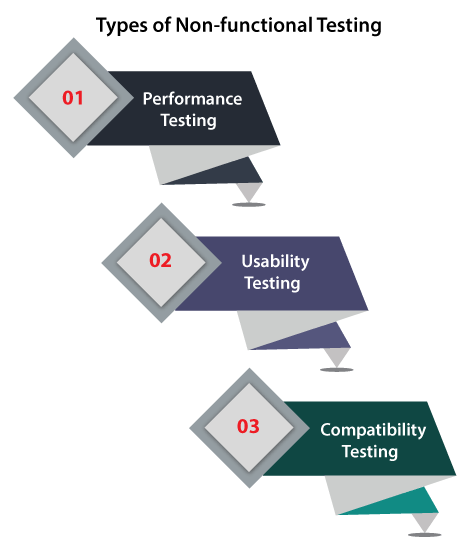
1. Performance Testing
In performance testing, the test engineer will test the working of an application by applying some load.
In this type of non-functional testing, the test engineer will only focus on several aspects, such as Response time, Load, scalability, and Stability of the software or an application.
Classification of Performance Testing
Performance testing includes the various types of testing, which are as follows:
- Load Testing
- Stress Testing
- Scalability Testing
- Stability Testing
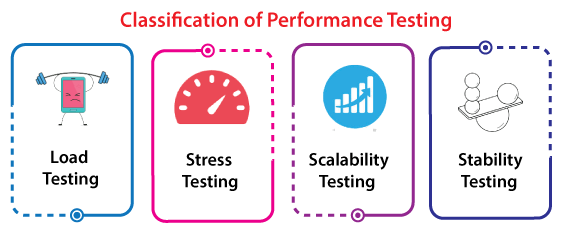
- Load Testing
While executing the performance testing, we will apply some load on the particular application to check the application’s performance, known as load testing. Here, the load could be less than or equal to the desired load.
It will help us to detect the highest operating volume of the software and bottlenecks.
To get the complete information related to the load testing refers to the below link:
https://tutoraspire.com/load-testing.
- Stress Testing
It is used to analyze the user-friendliness and robustness of the software beyond the common functional limits.
Primarily, stress testing is used for critical software, but it can also be used for all types of software applications.
Refers to the below link for in-depth knowledge of stress testing: https://tutoraspire.com/stress-testing.
- Scalability Testing
To analysis, the application’s performance by enhancing or reducing the load in particular balances is known as scalability testing.
In scalability testing, we can also check the system, processes, or database’s ability to meet an upward need. And in this, the Test Cases are designed and implemented efficiently.
Click on the following link to get the detailed information related to the scalability testing:
https://tutoraspire.com/scalability-testing.
- Stability Testing
Stability testing is a procedure where we evaluate the application’s performance by applying the load for a precise time.
It mainly checks the constancy problems of the application and the efficiency of a developed product. In this type of testing, we can rapidly find the system’s defect even in a stressful situation.
To get detailed information about the stability testing refers to the below link:
https://tutoraspire.com/stability-testing.
2. Usability Testing
Another type of non-functional testing is usability testing. In usability testing, we will analyze the user-friendliness of an application and detect the bugs in the software’s end-user interface.
Here, the term user-friendliness defines the following aspects of an application:
- The application should be easy to understand, which means that all the features must be visible to end-users.
- The application’s look and feel should be good that means the application should be pleasant looking and make a feel to the end-user to use it.
For more information about usability testing, we can refer to the following link:
https://tutoraspire.com/usability-testing.
3. Compatibility Testing
In compatibility testing, we will check the functionality of an application in specific hardware and software environments. Once the application is functionally stable then only, we go for compatibility testing.
Here, software means we can test the application on the different operating systems and other browsers, and hardware means we can test the application on different sizes.
To get a thorough knowledge of compatibility testing refer to the below link:
https://tutoraspire.com/compatibility-testing.
Grey Box Testing
Another part of manual testing is Grey box testing. It is a collaboration of black box and white box testing.
Since, the grey box testing includes access to internal coding for designing test cases. Grey box testing is performed by a person who knows coding as well as testing.

In other words, we can say that if a single-person team done both white box and black-box testing, it is considered grey box testing.
To get the in-details information about Grey box testing, we can refer to the below link:
https://tutoraspire.com/grey-box-testing.
Automation Testing
The most significant part of Software testing is Automation testing. It uses specific tools to automate manual design test cases without any human interference.
Automation testing is the best way to enhance the efficiency, productivity, and coverage of Software testing.
It is used to re-run the test scenarios, which were executed manually, quickly, and repeatedly.
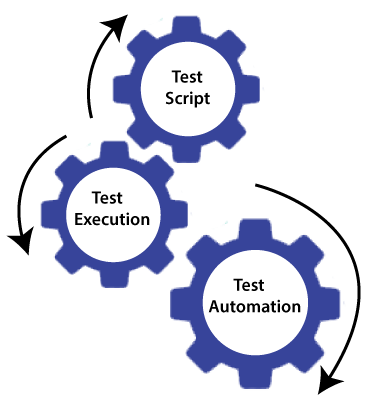
In other words, we can say that whenever we are testing an application by using some tools is known as automation testing.
We will go for automation testing when various releases or several regression cycles goes on the application or software. We cannot write the test script or perform the automation testing without understanding the programming language.
For more information about automation testing, we can refer to the below link:
https://tutoraspire.com/automation-testing.
Some other types of Software Testing
In software testing, we also have some other types of testing that are not part of any above discussed testing, but those testing are required while testing any software or an application.
- Smoke Testing
- Sanity Testing
- Regression Testing
- User Acceptance Testing
- Exploratory Testing
- Adhoc Testing
- Security Testing
- Globalization Testing
Let’s understand those types of testing one by one:
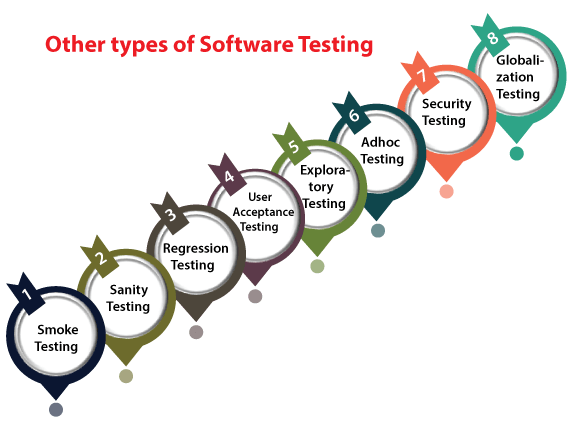
In smoke testing, we will test an application’s basic and critical features before doing one round of deep and rigorous testing.
Or before checking all possible positive and negative values is known as smoke testing. Analyzing the workflow of the application’s core and main functions is the main objective of performing the smoke testing.
For more information about smoke testing, refers to the following link:
https://tutoraspire.com/smoke-testing.
Sanity Testing
It is used to ensure that all the bugs have been fixed and no added issues come into existence due to these changes. Sanity testing is unscripted, which means we cannot documented it. It checks the correctness of the newly added features and components.
To get the in-detail information about sanity testing, we can refer to the below link:
https://tutoraspire.com/sanity-testing.
Regression Testing
Regression testing is the most commonly used type of software testing. Here, the term regression implies that we have to re-test those parts of an unaffected application.
Regression testing is the most suitable testing for automation tools. As per the project type and accessibility of resources, regression testing can be similar to Retesting.
Whenever a bug is fixed by the developers and then testing the other features of the applications that might be simulated because of the bug fixing is known as regression testing.
In other words, we can say that whenever there is a new release for some project, then we can perform Regression Testing, and due to a new feature may affect the old features in the earlier releases.
To get thorough knowledge related to regression testing, refer to the below link:
https://tutoraspire.com/regression-testing.
User Acceptance Testing
The User acceptance testing (UAT) is done by the individual team known as domain expert/customer or the client. And knowing the application before accepting the final product is called as user acceptance testing.
In user acceptance testing, we analyze the business scenarios, and real-time scenarios on the distinct environment called the UAT environment. In this testing, we will test the application before UAI for customer approval.
For more information about the User acceptance testing, click on the below link:
https://tutoraspire.com/acceptance-testing.
Exploratory Testing
Whenever the requirement is missing, early iteration is required, and the testing team has experienced testers when we have a critical application. New test engineer entered into the team then we go for the exploratory testing.
To execute the exploratory testing, we will first go through the application in all possible ways, make a test document, understand the flow of the application, and then test the application.
Click on the following link to get the complete information about exploratory testing:
https://tutoraspire.com/exploratory-testing.
Adhoc Testing
Testing the application randomly as soon as the build is in the checked sequence is known as Adhoc testing.
It is also called Monkey testing and Gorilla testing. In Adhoc testing, we will check the application in contradiction of the client’s requirements; that’s why it is also known as negative testing.
When the end-user using the application casually, and he/she may detect a bug. Still, the specialized test engineer uses the software thoroughly, so he/she may not identify a similar detection.
Refers to the following to get the in-detail information about Adhoc testing:
https://tutoraspire.com/adhoc-testing.
Security Testing
It is an essential part of software testing, used to determine the weakness, risks, or threats in the software application.
The execution of security testing will help us to avoid the nasty attack from outsiders and ensure our software applications’ security.
In other words, we can say that security testing is mainly used to define that the data will be safe and endure the software’s working process.
To get the complete detail about security testing, refer to the below link: https://tutoraspire.com/security-testing.
Globalization Testing
Another type of software testing is Globalization testing. Globalization testing is used to check the developed software for multiple languages or not. Here, the words globalization means enlightening the application or software for various languages.
Globalization testing is used to make sure that the application will support multiple languages and multiple features.
In present scenarios, we can see the enhancement in several technologies as the applications are prepared to be used globally.
Refer to the following link to get the completed information related to the globalization testing:
https://tutoraspire.com/globalization-testing.
Conclusion
In the tutorial, we have discussed various types of software testing. But there is still a list of more than 100+ categories of testing. However, each kind of testing is not used in all types of projects.
We have discussed the most commonly used types of Software Testing like black-box testing, white box testing, functional testing, non-functional testing, regression testing, Adhoc testing, etc.
Also, there are alternate classifications or processes used in diverse organizations, but the general concept is similar all over the place.
These testing types, processes, and execution approaches keep changing when the project, requirements, and scope change.
